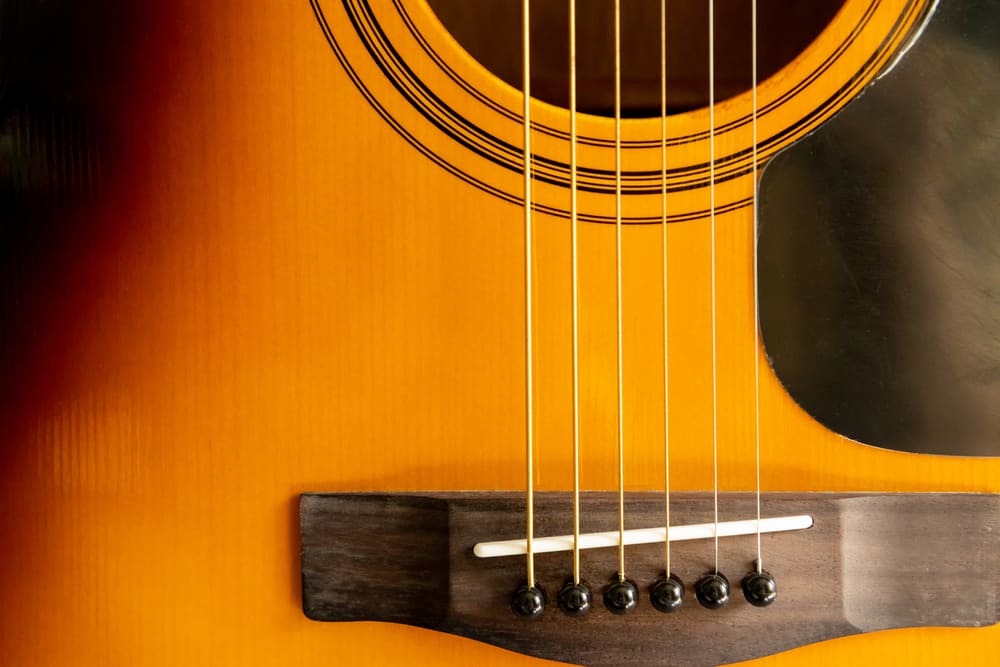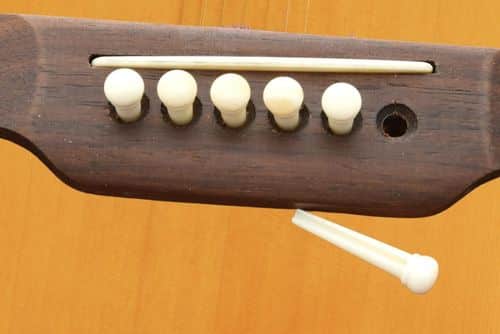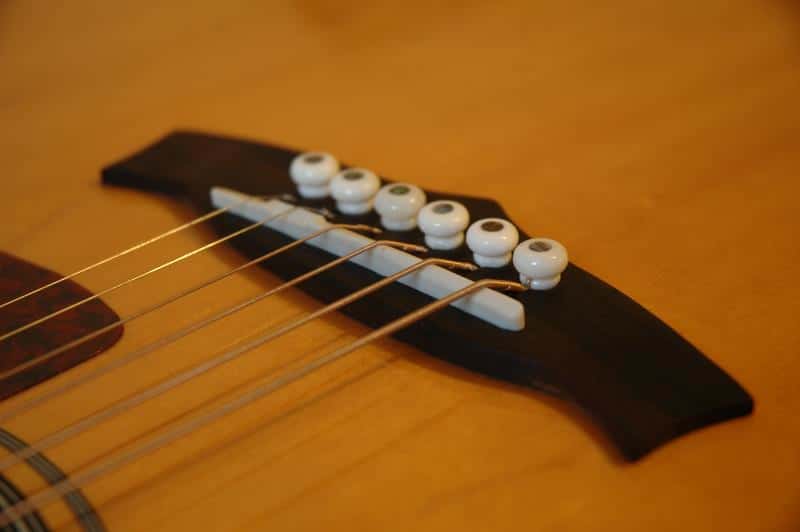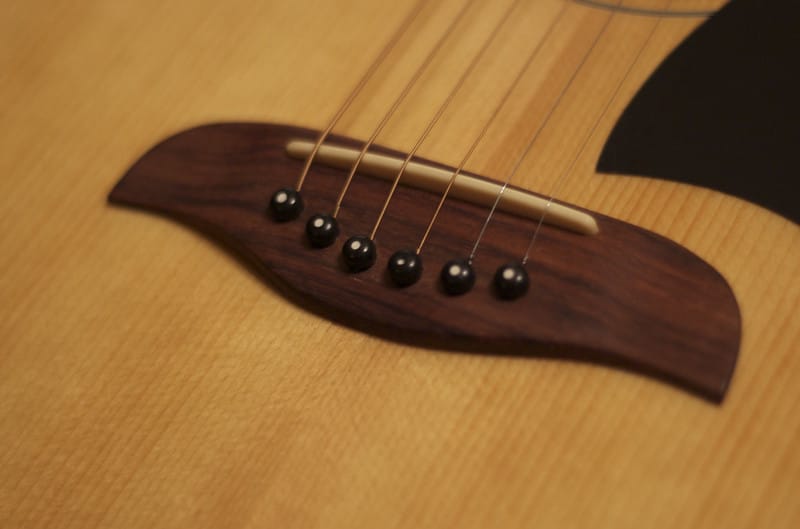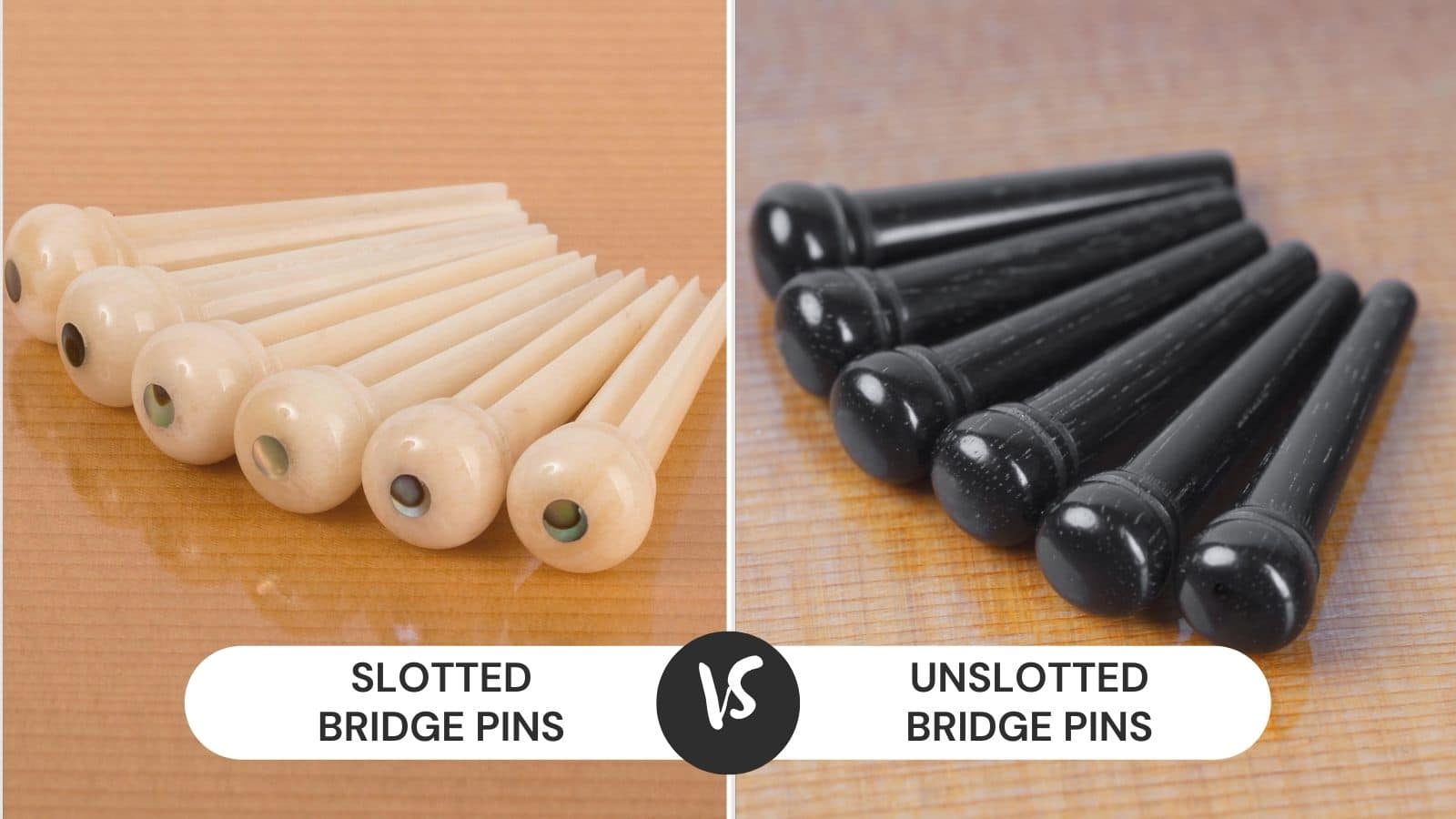
When you are learning to play the guitar, it’s important to understand all the components and the formation on it. Different parts of a guitar are connected to each other and require adjustments and tuning, which you learn along the way.
But tuning isn’t everything, and sometimes you need a guitar with certain components to create a different sound or perform in a different playing style. Bridge pins are one such component.
Why Are They Necessary?
Bridge pins are the parts that are used to anchor the strings in acoustic guitars to the bridge. A string is first passed into a hole inside the bridge, then a bridge pin pushes the string into place and secures it.
The free end of the string is then passed over a nut present at the base of the fingerboard and attached to the machine heads.
The string is tuned into the proper pitch using these mechanical heads. However, the pitch will be corrected differently depending on the size, material, and shape of your bridge pins.
That’s why getting the correct bridge pins is so important. Bridge pins might seem insignificant to newbies, but they are crucial to finding the right tone and have an important part in the final intonation of the instrument.
Bridge pins work to filter frequencies out, which affects the output frequency spectrum of the guitar. Bridge pins also affect the sustain of the tone and the overall volume.
If your guitar is producing disappointing results, upgrading the bridge pins can benefit the sustain and increase the clarity.
But just a heads up, bridge pins can produce somewhat of a different result if there are temperature changes or increase or decrease in humidity.
The shape and material of the bridge pin can also steer a guitar to increase or decrease bass and tremble production. These can be adjusted though, but different bridge pins give different range of adjustment when it comes to bass.
You can use bridge pins of different colours and types. They’re crucial in determining the guitar’s sound quality.
Typically, there are two kinds of bridge pins found in modern guitars- slotted and unslotted. The obvious difference is between pre-defined slots on these pins that tie the strings, and you don’t need a slotted bridge itself.
However, there’s a lot more going on with the guitar’s intonation and playing style that you should know about before deciding between the two kinds of bridge pins.
Some key differences to know between slotted and unslotted types of bridge pins are mentioned below. Let’s dissect!
Slotted Bridge Pins vs Unslotted Bridge Pins
| Features | Slotted Bridge Pins | Unslotted Bridge Pins |
|---|---|---|
| Bridge | Uses an unslotted bridge. | Uses a slotted bridge. |
| Slot Size | Each slot is big enough for the 6th string, which can leave the other 5 strings sloppy. | Each slot has the right size for individual strings. |
| Durability | Less durable because of high force on the pins from the string ball, which causes wear. | More durable because of the string being bent at a low angle, which creates less tension on the pin itself. |
Slotted Bridge Pins
Slotted bridge pins are used when the guitar has an unslotted bridge itself. These are used to keep the bridge in the correct position firmly so no string comes off.
It’s important to avoid have either your pins or your bridge slotted anything from going awry. Using slotted bridge pins on an unslotted bridge gives you the perfect intonation on the instrument.
Usage
As bridge pins go inside the bridge of a guitar, using slotted bridge pins on a slotted bridge guitar is likely going to give you alignment issues. You’ll require more adjustments with the mechanical heads and it will be quite inconvenient.
To make the most out of your guitar and make it more playable and easy to tune, it’s advised to keep the bridge unslotted when using slotted bridge pins.
Slotted pins work by using the pin slot to anchor the guitar string against the plate, but they must remain in place to keep holding the string.
They’re a cheap and easy solution for building a guitar and are generally found in less costly options, though it doesn’t make them inferior to unslotted pins, as the materials of the pins itself is an important deciding factor.
However, do note that the slotted pins can cause damage to the plate over a long span of time.
Design
Shape-wise, slotted bridge pins have a curved edge that keeps your bridge as well as the strings in it at the right amount of tension so you’re able to play the instrument.
Slotted pins having unslotted bridges are generally used by musicians who want to try playing aggressive genres like pop, rock, EDM, or blues on their guitars. These are the genres that require you to have total control of the guitar strings.
If you feel like the slotted pins aren’t working for you, or if one slotted pin is leaving the other five strings sloppy, you can always go to a guitar tech and have the bridge ramped. Then, the pins will be spun 180 degrees for later use.
Unslotted Bridge Pins
As suggested by the name, unslotted bridge pins don’t feature any slots on them, allowing you to tune the instrument more.
They’re always paired with slotted bridges to make sure the guitar string balls are at the correct angle and hold enough tension.
Unslotted bridges don’t need to be jammed into their slots, and just act to jam the ball end of the string at the end of the guitar’s pin hole
Usage
Unslotted pins are used with ramped and slotted bridges. They work by pushing the string ball under the top bridge plate.
The tension that holds the strings is created once the guitar is tuned. You can even remove the pin once your guitar is tuned. You get great resnaonce too.
Unslotted pins offer good accuracy, but they shine when it comes to ensuring limited wear and tear- they don’t rub against the bridge to affect the plate, nor do they rub on the string and wear out.
Guitars with unslotted bridge pins don’t tune out quickly. Unslotted bridge pins are great for playing all genres of music, however they’re better in live settings or for long concerts as you don’t have to tune them often.
Setting the string on moderate tension keeps it more versatile. Unslotted pins can also be rotated easily and you have full control of the string tension and pressure whilst playing.
Should You Switch Between Slotted And Unslotted Pins?
This is a hard question to answer, seeing as both have their perks in playability, although the end results aren’t too far off if you’ve tuned the guitar right.
However, do note that without slots in the pins, you may need to do some extra work on the pins to get them to fit.
Not just that, but fixing guitar strings on both an unslotted bridge and unslotted pins is quite difficult, while having slots in both just leads to alignment problems.
So in short, it’s best to avoid modifying your guitar, even if it’s just replacing unslotted pins with slotted ones (or vice versa).
Modifying by getting pins of different material can also affect the sound quality (for example woods absorb humidity which metal doesn’t).
It’s best to consult an expert first if you have damaged pins you want replaced. And as for the shape, we advise you to keep using the pins you already have.
The Winner
Whether you go for slotted pins with unslotted bridge or unslotted pins with slotted bridge, the final result and tone of your guitar remains quite similar if you’ve properly tuned the instrument.
However, the shape does affect the durability and need for adjusting. We prefer using unslotted pins with slotted bridges, as they don’t need to jam the bridge to create tension and are much more durable.

